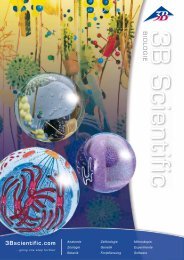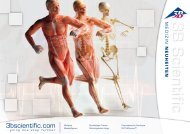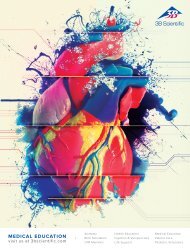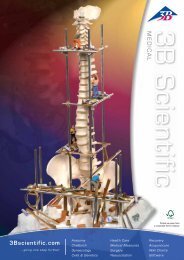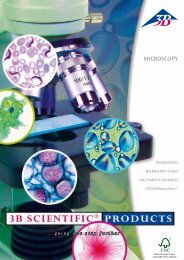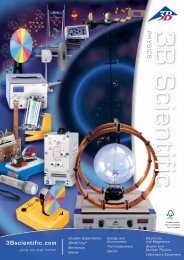3B Scientific - Biology Catalog
3Bscientific.com
3Bscientific.com
You also want an ePaper? Increase the reach of your titles
YUMPU automatically turns print PDFs into web optimized ePapers that Google loves.
Experiments Electrophoresis / PCR<br />
9982-1005879<br />
Polymerase Chain Reaction<br />
This experiment for 6 lab groups introduces students to the principles,<br />
practice and applications of the Polymerase Chain Reaction (PCR) without<br />
the need for a PCR machine! Polymerase Chain Reaction (PCR) has had an<br />
extraordinary impact on various aspects of biotechnology. With PCR, DNA<br />
can be amplified and studied. Since the first application of PCR (using the<br />
Klenow fragment) to detect sickle cell anaemia, a large number of diagnostic<br />
tests have been developed. PCR has made amplification of DNA an alternate<br />
approach to cloning experiments. It is used in genome projects in<br />
DNA mapping and DNA sequencing. PCR amplification is also being applied<br />
to forensic and paternity determination, as well as determination of evolutionary<br />
relationships. This simulation experiment does not contain human<br />
DNA and does not require a thermal cycler. It is completed in 45 minutes.<br />
Scope of delivery:<br />
Ready-to-Load DNA samples, Ultraspec agarose powder, practice gel<br />
loading solution, electrophoresis buffer, Instastain® Methylene Blue and<br />
Methylene Blue Plus stain, calibrated pipette, 100 ml graduated cylinder<br />
and microtipped transfer pipettes.<br />
Additionally required:<br />
Electrophoresis tank, power supply, automatic micropipette and tips,<br />
balance, microwave or hot plate.<br />
30x10x10 cm; 0.5 kg<br />
& D/E<br />
9982-1005879<br />
EdvoCycler PCR Machine<br />
(9982-1005882<br />
Page 113<br />
9982-1005883<br />
Mitochondrial DNA Analysis Using PCR<br />
In this experiment, your students will use the Nobel Prize winning technique<br />
polymerase chain reaction (PCR) to amplify two regions of DNA from<br />
their mitochondria. The mitochondria are thought to have evolved from a<br />
symbiotic relationship between prokaryotic and eukaryotic cells. Thus as<br />
mitochondria have their own DNA that is only inherited via the maternal<br />
line they are often used in studies of evolution. This kit shows how PCR is<br />
able to amplify DNA from just a few cells. This ability has made PCR very<br />
useful to study evolution and in forensics and genetic testing. Your students<br />
carry out a simple DNA extraction, followed by PCR, then analyse the results<br />
using DNA electrophoresis.<br />
Scope of delivery:<br />
Instructions, proteinase K, PCR beads, control DNA and primers, microtubes,<br />
chelating agent, agarose, DNA ladder, practice gel loading solution,<br />
gel loading dye, electrophoresis buffer, gel stain.<br />
Additionally required:<br />
Micropipettes to measure between 5 and 50 μl, tips, waterbath, thermal<br />
cycler (PCR machine), electrophoresis tank and power supply.<br />
For 25 Students<br />
Time required:<br />
Set up 30 min.<br />
PCR 2 hours or overnight<br />
Electrophoresis 45 min.<br />
& D/E/F/S/I<br />
9982-1005883 Some components<br />
of this kit must be<br />
stored at -20 °C<br />
ATTENTION:<br />
This experiment requires an<br />
electrophoresis chamber and<br />
a suitable power supply.<br />
(Page 114)<br />
!<br />
136<br />
<strong>3B</strong> <strong>Scientific</strong>® <strong>Biology</strong>




